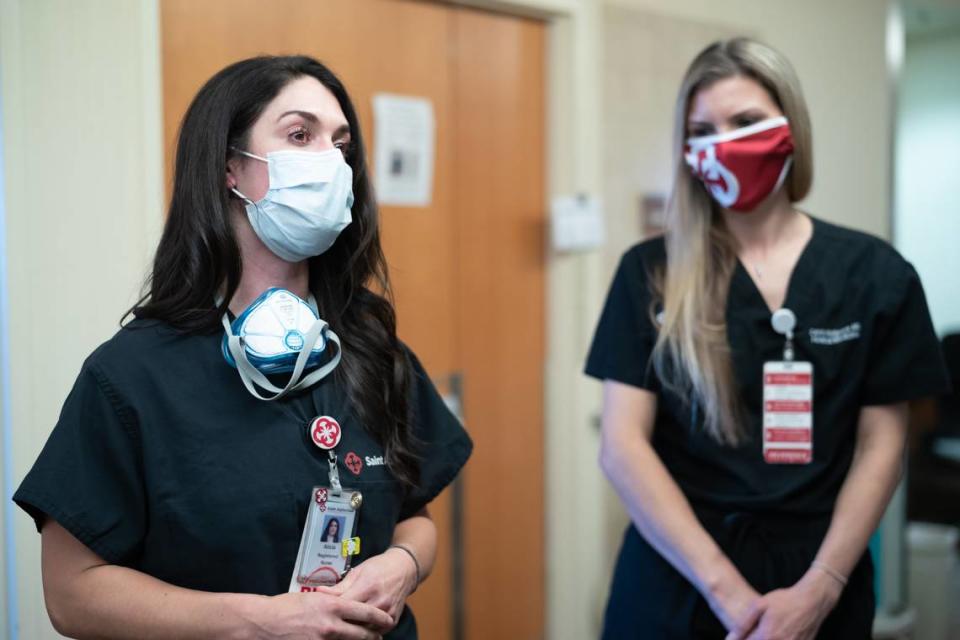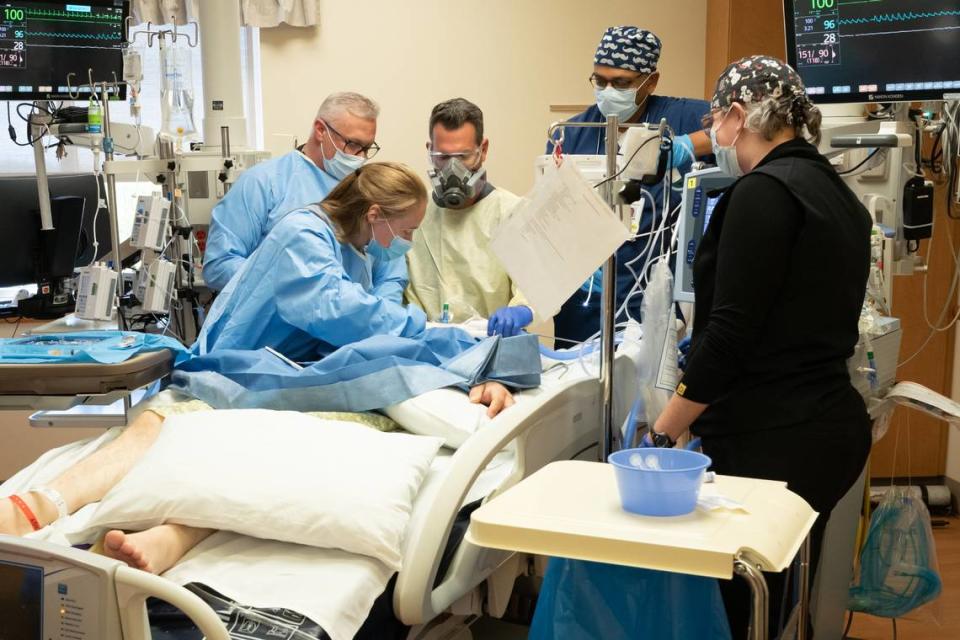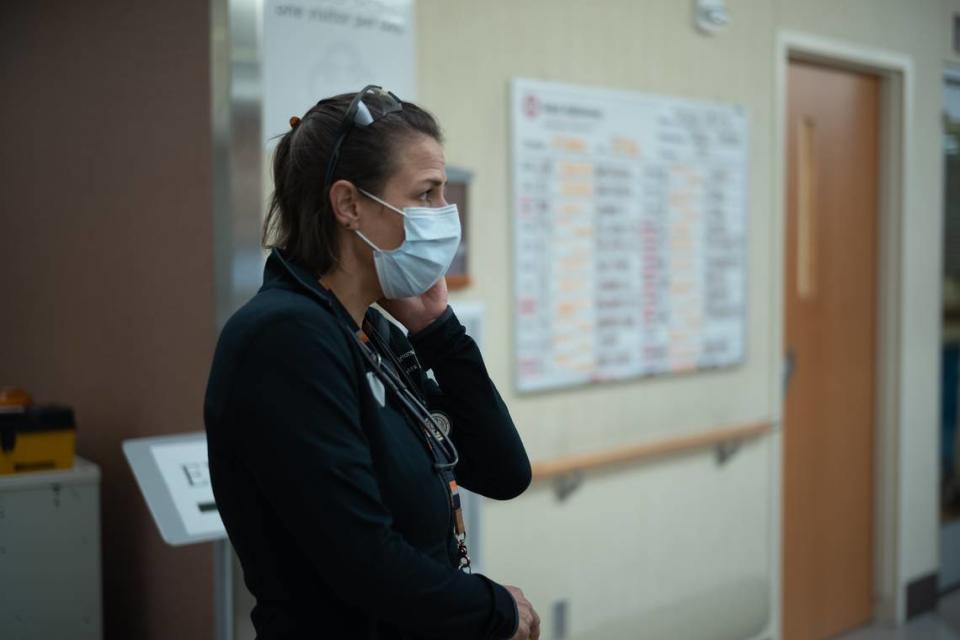‘I feel like we broke the system’: Inside the fight against COVID-19 at Saint Al’s in Boise
Room after room was occupied by an unvaccinated COVID-19 patient. The steady tone of a heart-rate monitor could be heard on the floor. Inside Saint Alphonsus’ cardiac intensive care unit in Boise, a 33-year-old COVID-19 patient lay in a hospital bed, prone on his stomach. Monitors and fluids surrounded him. Blue compression sleeves were strapped around his calves to prevent blood clots.
Right outside his room, Jessica Parrott, a registered nurse, spoke to a handful of coworkers in a hushed voice with a hardened face. She was clutching an iPad. The floor grew quiet. Parrott would soon set up a video call with the wife of another unvaccinated patient in his 50s, right before he’s put on a ventilator.
Unable to breathe on his own, a doctor would insert a tube into the patient’s windpipe, hooking him to a machine that would pump extra oxygen into his lungs. Only half of intubated patients leave the hospital alive, doctors say. This call, with his family, could be his last.
Dr. Meghan McInerney began to choke up.
“We’re done,” McInerney said. “We’re tired of it.”
Overwhelmed by COVID-19 patients, and having exhausted all other contingency measures, Idaho implemented crisis standards of care statewide Thursday morning. Hospitals under crisis standards can ration care, in an effort to save as many lives as possible. Patients may face long wait times to get care, or get sent home with treatments when they would be offered a hospital bed under normal circumstances.
Dr. Steven Nemerson of Saint Al’s said no patients so far have been taken off life support so another patient with a better prognosis could have it. But that’s in Idaho’s future “if we continue on this path,” he said.
COVID-19 is a respiratory disease that causes inflammation in the lungs — so much inflammation in the lung tissue, it can prevent the lung’s air sacks from delivering oxygen into the bloodstream.
McInerney, who specializes in pulmonary medicine, said ventilators insert high volumes of pressure into the lungs to try to forcibly open the air sacks. Over time, though, inflammation can turn lungs into scar tissue. They grow stiff — and the organs can no longer expand. Sometimes patients’ kidneys will shut down. Sometimes patients get blood clots. And sometimes, patients’ brains can be slowed by COVID-19.
Saint Al’s reported Thursday that it had 144 COVID-19 patients hospitalized in its health system. That’s more than the entire state of Idaho had as recently as late July.
The flow of COVID-19 patients at Saint Al’s has had a cascading effect on care, said Dr. Andrew Southard, a Saint Al’s emergency medicine physician. What once was a conference room pre-Zoom era became a supply closet, where oxygen canisters, respiratory equipment and folded gowns now reside. Shortly after 10:30 a.m. Thursday, a typically slow time in the Emergency Department, 28 of the roughly 30 beds were taken. Of those, 16 patients were waiting for a bed upstairs. Two beds in the ER hallway were pre-staged, in case the ER ran out of rooms.
On Monday afternoon, Southard said the ER beds were full. He was treating a patient in the hallway, while three ambulances waited for beds to open.

‘We keep fighting’ — even when patients are skeptical
Dr. Carolyn McFarlane, who works in the Saint Al’s COVID-19 unit, said when one patient told her to do what she thinks is best, she broke down in tears. It had been so long since she heard those words, she said. Instead it was a constant battle of “trying to convince our patients that we do know what we’re doing,” that they weren’t part of a conspiracy involving Anthony Fauci and pharmaceutical companies.
“We are trying to save their lives, and this is not political for us,” McFarlane said. “This is a matter of an oath that we took to save our community.”
At times, COVID-19 patients who sought help in the ER are too late. Earlier this week, Southard said, one patient got COVID-19, went into cardiac arrest in the lobby and died.
Southard said he doesn’t press patients on the COVID-19 vaccine. But when he gets asked whether they should tell their family to get vaccinated, he responds: “Yes, I think that would be a good idea,” he said with a laugh. “Would you like to borrow my phone?”
The Saint Al’s COVID-19 unit on the fifth floor operated on a ratio of five patients for every nurse Thursday, said Alicia Luciani, a registered nurse in the unit. But whenever she’s discouraged, she thinks of her unvaccinated parents and siblings — and the kind of care she would want them to receive. She stays in this job, she said, for them and for her 11-year-old daughter.
“I don’t want this world to be a new reality for her,” Luciani said. “So we keep fighting. And we keep helping people.”

‘Abhorrent’ leadership irks health care workers
Dr. Wes Pidcock, who was working in Boise on his day off, said he averages seeing two intubations for COVID-19 a day in his Nampa hospital. Pidcock said the difficult part is seeing the disconnect between the reality inside hospital walls and the public’s behavior.
“So you see this,” Pidcock said, referring to the COVID-19 cases, “and then you go to, like, Whole Foods. … You’re the only one wearing a mask, and you’re the one getting the strange looks.”
Luciani said health care workers have been “horrified” by the lack of statewide leadership among Idaho’s politicians.
“The lack of solid leadership that we’ve had in this community with consistent guidelines and clear messages has been abhorrent,” Luciani said. “If you walked into poisonous gas, sarin gas, and the leadership you were with said, ‘Hey, put on your gas mask or you’re gonna die,’ you would do it. Nobody’s willing to do that here, is what it feels like.”
State public health officials and Gov. Brad Little have continued to encourage Idaho residents to get vaccinated against COVID-19. But Little has said he has no plans to implement statewide restrictions used in previous COVID-19 surges, such as limiting large gatherings. Mask mandates have also largely been removed or ignored by the public.
“We will continue to support our hospitals by adding staff and by making monoclonal antibody treatments available – which are effective in reducing COVID-19 hospitalizations but should not be considered an alternative to the safe and effective vaccine,” Little said in a Thursday statement. “Idahoans, please come together to protect yourselves and our communities, and to thank our heroes in health care. Together, and only together, will we get through this very challenging time in our state’s history.”

Health care workers tired, frustrated over vaccine resistance
In interviews at the Saint Al’s hospital with the Idaho Statesman and Idaho Capital Sun on Thursday, doctors and registered nurses described the anger, fatigue, burnout and frustration they felt 18 months into the coronavirus pandemic.
“Defeated” — that’s how McFarlane felt when she woke up to the crisis standards news. Saint Alphonsus Regional Medical Center has not yet implemented crisis standards. The hospital could take that step soon.
“I feel like we broke the system in many ways,” McFarlane said, her voice trembling with emotion. Trust and respect among patients is eroding, she said. To see a record-breaking number of hospitalizations every day, when a vaccine is available, “That, to me, is just unbelievable,” she said.
“It’s a defeat,” she added. “We are entering a phase of care that none of us expected really in the initial phases.”
Nurses and doctors are working extra shifts as turnover remains high. At Saint Al’s, doctors and nurses said that turnover is largely because of burnout. St. Luke’s officials on Thursday also said they have 400 staffers out sick due to COVID-19 exposure.
McFarlane said she no longer worries about the elderly population with comorbidities; she worries for the unvaccinated parents. Young children and teens seeing their parents’ conditions worsen, “That’s just beyond what I can handle sometimes as a clinician,” McFarlane said.
McFarlane and Luciani said they’re frustrated by the resistance to medical advice or proper COVID-19 treatments.
McFarlane urged residents to listen to their physicians and health care providers — and trusted federal health care guidance — above the anecdote from a neighbor about an adverse reaction to the vaccine.
“I really want to encourage the public … to consider your sources as if your life depended on it,” McFarlane said. “Because it does right now.”

